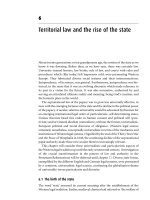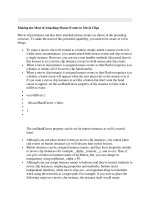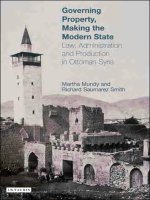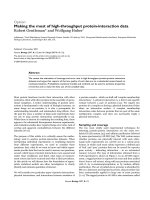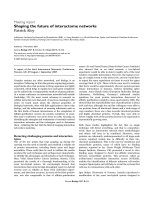Making the modern american fiscal state law, politics, and the rise of progressive taxation, 1877 1929
Bạn đang xem bản rút gọn của tài liệu. Xem và tải ngay bản đầy đủ của tài liệu tại đây (3.22 MB, 448 trang )
Making the Modern American Fiscal State
Law, Politics, and the Rise of Progressive Taxation, 1877–1929
At the turn of the twentieth century, the U.S. system of public finance
underwent a dramatic transformation. The late nineteenth-century
regime of indirect, hidden, partisan, and regressive taxes was eclipsed
in the early twentieth century by a direct, transparent, professionally
administered, and progressive tax system. This book uncovers the contested roots and paradoxical consequences of this fundamental shift in
American tax law and policy. It argues that the move toward a regime
of direct and graduated taxation marked the emergence of a new fiscal polity – a new form of statecraft that was guided not simply by
the functional need for greater revenue but by broader social concerns
about economic justice, civic identity, bureaucratic capacity, and public
power. Between the end of Reconstruction and the onset of the Great
Depression, the intellectual, legal, and administrative foundations of
the modern fiscal state first took shape. This book explains how and
why this new fiscal polity came to be.
Ajay K. Mehrotra teaches law and history at the Maurer School of
Law at Indiana University, Bloomington. He is co-editor of The New
Fiscal Sociology: Comparative and Historical Approaches to Taxation
(Cambridge, 2009). Research for this book was supported by the
American Academy of Arts & Sciences, the National Endowment for
the Humanities, and the William Nelson Cromwell Foundation.
Cambridge Historical Studies in American Law and Society
Series Editor
Christopher Tomlins, University of California, Irvine
Previously published in the series:
Yvonne Pitts, Family, Law, and Inheritance in America: A Social and Legal History
of Nineteenth-Century Kentucky
David M. Rabban, Law’s History
Kunal M. Parker, Common Law, History, and Democracy in America, 1790–1900
Steven Wilf, Law’s Imagined Republic
James D. Schmidt, Industrial Violence and the Legal Origins of Child Labor
Rebecca M. McLennan, The Crisis of Imprisonment: Protest, Politics, and the Making
of the American Penal State, 1776–1941
Tony A. Freyer, Antitrust and Global Capitalism, 1930–2004
Davison Douglas, Jim Crow Moves North
Andrew Wender Cohen, The Racketeer’s Progress
Michael Willrich, City of Courts, Socializing Justice in Progressive Era Chicago
Barbara Young Welke, Recasting American Liberty: Gender, Law and the Railroad
Revolution, 1865–1920
Michael Vorenberg, Final Freedom: The Civil War, the Abolition of Slavery, and the
Thirteenth Amendment
Robert J. Steinfeld, Coercion, Contract, and Free Labor in Nineteenth Century
America
David M. Rabban, Free Speech in Its Forgotten Years
Jenny Wahl, The Bondsman’s Burden: An Economic Analysis of the Common Law of
Southern Slavery
Michael Grossberg, A Judgment for Solomon: The d’Hauteville Case and Legal
Experience in the Antebellum South
Making the Modern American Fiscal State
Law, Politics, and the Rise of Progressive Taxation, 1877–1929
AJAY K. MEHROTRA
Indiana University, Bloomington
32 Avenue of the Americas, New York, ny 10013-2473, usa
Cambridge University Press is part of the University of Cambridge.
It furthers the University’s mission by disseminating knowledge in the pursuit of
education, learning, and research at the highest international levels of excellence.
www.cambridge.org
Information on this title: www.cambridge.org/9781107043923
C
Ajay K. Mehrotra 2013
This publication is in copyright. Subject to statutory exception
and to the provisions of relevant collective licensing agreements,
no reproduction of any part may take place without the written
permission of Cambridge University Press.
First published 2013
Printed in the United States of America
A catalog record for this publication is available from the British Library.
Library of Congress Cataloging in Publication data
Mehrotra, Ajay K., 1969–
Making the modern American fiscal state : law, politics, and the rise of progressive
taxation, 1877–1929 / Ajay K. Mehrotra, Indiana University.
pages cm
Includes index.
isbn 978-1-107-04392-3 (hard covers : alk. paper)
1. Taxation – United States – History. 2. Fiscal policy – United States – History.
3. Taxation – Law and legislation – United States – History. I. Title.
hj2373.m44 2014
336.200973–dc23
2013013590
isbn 978-1-107-04392-3 Hardback
Cambridge University Press has no responsibility for the persistence or accuracy of urls
for external or third-party Internet Web sites referred to in this publication and does not
guarantee that any content on such Web sites is, or will remain, accurate or appropriate.
For my parents, Neena and Vishnu
Contents
List of Tables, Charts, and Illustrations
Acknowledgments
Introduction
1
2
3
4
5
6
7
page xi
xiii
1
part i: the old fiscal order
The Growing Social Antagonism: Partisan Taxation and
the Early Resistance to Fiscal Reform
37
The Gradual Demise: Modern Forces, New Concepts, and
Economic Crisis
86
part ii: the rise of the modern fiscal state
The Response to Pollock: Navigating an Intellectual
Middle Ground
The Factories of Fiscal Innovation: Institutional Reform at
the State and Local Level
Corporate Capitalism and Constitutional Change: The
Legal Foundations of the Modern Fiscal State
part iii: consolidating the new fiscal order
Lawyers, Guns, and Public Monies: The U.S. Treasury,
World War I, and the Administration of the Modern
Fiscal State
The Paradox of Retrenchment: Postwar Republican
Ascendancy and the Resiliency of the Modern
Fiscal State
143
185
242
293
349
Conclusion
409
Index
419
ix
Tables, Charts, and Illustrations
Tables
I.1 Federal Government Receipts by Source, 1880–1930
1.1 Alcohol Excise and Federal Government Revenue, Internal and
Total, 1880–1913
1.2 Nineteenth-Century Independent Parties Favoring an Income Tax
4.1 State and Local Government Receipts by Source, 1890–1932
4.2 State and Local Government Debt Levels, 1880–1927
6.1 Maximum Marginal Tax Rates and Tax Revenues by Source,
Fiscal Years 1913–1921
6.2 Increases in Corporate Profits of Select U.S. Corporations,
1914–1916
7.1 Top Personal Income Tax Rates, and Sources of Tax Revenue,
1916–1929
7.2 Sources of Individual Income, 1916–1930
page 7
72
81
193
199
300
333
352
403
Charts
2.1 Industrializing Nations: Real GDP per Capita, 1870–1930
6.1 Growth of Bureau of Internal Revenue, 1915–1925
90
306
Illustrations
1.1
1.2
2.1
3.1
5.1
5.2
6.1
7.1
“Difference Between Trimming a Hedge and Cutting it Down”
“How the Tariff Robs the Farmer and Every Workingman”
The Progressive Public Finance Economists
“The Latest Unfortunate Experience of an Unfortunate Animal”
The Lawmakers
“The New Man on the Job”
The Treasury Lawyers
1920 Taxpayers Lined Up To Pay Their Income Taxes
xi
48
52
102
145
265
279
309
357
Acknowledgments
It is only fitting that a book about the importance of social obligations
and collective responsibilities – as embodied in changing conceptions of
taxation – should begin by acknowledging the many people and institutions that helped make this book possible. This book began, more years
ago than I care to recall, as a doctoral thesis in the history department at
the University of Chicago. There a committee of dedicated historians consisting of Bill Novak, Kathy Conzen, and Amy Stanley helped guide my
initial interests in taxation and American state building. At U of C, I also
benefited from an interdisciplinary intellectual environment developed
by scholars such as Andy Abbott, David Galenson, and Gary Herrigel,
and sustained by fellow graduate students Amy Amoon, Doug Bradburn,
Cathleen Cahill, Joanna Grisinger, Scott Lien, Matt Lindsay, Rebecca
Mergenthal, Kim Reilly, Andrew Sandoval-Strausz, Tracy Steffes, and
Mark Wilson.
Before graduate school, my interests in taxation and legal history began
at the Georgetown University Law Center. There, Dan Halperin first
demonstrated to me how tax law and policy affected nearly every aspect
of daily life. Indeed, my interest in taxation can be traced back to the
many lessons I learned working with Dan. Similarly, Dan Ernst, Mark
Tushnet, and Norman Birnbaum cultivated my interests in American legal
history and encouraged me to pursue that interest in graduate school. Dan
Ernst in particular has been instrumental in shaping this book and my
development as a scholar and teacher.
The process of transforming the dissertation into this book took place
at Indiana University, Bloomington. At IU, I have been fortunate to have
a generous and thoughtful group of colleagues – at the Maurer School
of Law and elsewhere – who have encouraged, critiqued, and supported
my scholarship. Many of these colleagues read early draft portions of this
book, often multiple times, and provided me with outstanding comments:
thanks to Jeannine Bell, Dan Conkle, Ken Dau-Schmidt, Charlie Geyh,
xiii
xiv
Acknowledgments
Alex Lichtenstein, Leandra Lederman, Mike McGerr, John Mikesell, Carl
Weinberg, Susan and David Williams, Elisabeth Zoller, and especially
Mike Grossberg and Bill Popkin who have been consistent and generous
mentors throughout my career. The students in my legal history seminar and my many research assistants over the years read and discussed
a great deal about the rise of the American fiscal state. I am indebted to
many of these students, particularly Charles Persons, Collin McCready,
James Motter, Ryan Guillory, Joel Koerner, Dustin Plummer, Lisa Fahey,
Ken Burleson, Charles Gray, Scott Ritter, and especially Megan McMahon who more than any other research assistant helped see this book
to completion. Deans Lauren Robel and Hannah Buxbaum provided a
valuable sabbatical and summer funding to complete this project. The
staff and librarians at the law library, especially Keith Buckley, Jennifer
Bryan Morgan, and Rebecca Bertoloni-Meli, provided critical research
assistance. And my friends and colleagues Luis Fuentes-Rohwer, Jay
Krishnan, Ethan Michelson, Christy Ochoa, and Tim Waters have read
and commented on more of my scholarship than they care to admit, and
in the process they’ve reminded me of the true meaning of a scholarly
community of friends.
Many other scholars and friends also took on the social obligation to
review and provide comments on various portions of this book and in
many cases the entire manuscript. I am grateful to Mark Aldrich, Reuven
Avi-Yonah, Steve Bank, Gerry Berk, Michael Bernstein, Cheryl Block,
Dorothy Brown, Richard Bensel, Andrea Campbell, Chris Capazolla,
Lawrence Friedman, David Galenson, Dan Halperin, Richard John, Marianne Johnson, Robert Johnston, Carolyn Jones, Marjorie Kornhauser,
Mark Leff, Shu-Yi Oei, Julia Ott, Sheldon Pollack, Gautham Rao, Adam
Rosenzweig, Bruce Schulman, Steve Sheffrin, David Tannenhaus, Jon
Teaford, Mark Tushnet, Dennis Ventry, Jr., Michael Willrich, Vicky
Woeste, and Julian Zelizer. A special group of friends and colleagues
read the entire manuscript, provided trenchant comments, and have been
discussing our mutual interest in fiscal history for many years: I am deeply
indebted for all that I have learned from Elliot Brownlee, Robin Einhorn,
Isaac Martin, Monica Prasad, and Joe Thorndike.
Numerous institutions and the individuals associated with them have
also assisted me with this project. Generous funding support from the
William Nelson Cromwell Foundation, the National Endowment for the
Humanities, and the American Academy of Arts & Sciences helped launch
the writing of this book. In fact, the first draft of the book began when I
was a Visiting Scholar at the American Academy. There Leslie Berlowitz
Acknowledgments
xv
and Patricia Spacks created a welcoming environment for junior scholars,
and an energetic group of fellow visiting scholars consisting of Victoria
Cain, Taylor Fravel, Tony Mora, Bethany Moreton, Laura Scales, and
Anne Stiles made the year in Cambridge productive and enjoyable.
After a brief hiatus to work on other research, I was able to return to
this project during a sabbatical semester at the IU Institute for Advanced
Study, where John Bodnar and Ivona Hedin provided me with the space
and time to re-engage with the manuscript. During that time and afterwards, I had the opportunity to present portions of the book at the annual
meetings of the Law & Society Association, the Social Science History
Association, the Midwest Political Science Association, and the American
Society for Legal History, as well as at workshops at Emory University,
Washington University in St. Louis, Tulane University, and the IU Ostrom
Workshop in Political Theory and Policy Analysis. I am grateful for the
comments I received at these venues. All of the above individuals helped
me clarify my arguments and avoid mistakes. Any remaining errors are,
of course, my own.
Much of the research contained in this book would not have been possible without the assistance of librarians, archivists, and staff at numerous
libraries. Among the many libraries and archives that I consulted, I am
especially thankful for the assistance I received at the Library of Congress,
the National Archives and Record Administration (both in Washington,
D.C., and in College Park, Md.), Columbia University’s Butler Library,
the University of Michigan’s Bentley Library, the University of Chicago’s
Regenstein Library, the Harvard University Libraries, the Hebert Hoover
Presidential Library, the Newberry Library, the Wisconsin State Historical Society, and the Yale University Libraries.
Back when this book was merely an idea, Chris Tomlins believed in
this project and its author. His patience and assistance as an editor,
mentor, and friend have been invaluable. The two anonymous referees
also provided useful guidance. One of them (Brian Balogh) disclosed his
identity and generously provided continued assistance. Indeed, Brian, like
Chris, has been molding my research and scholarship from the start of
my career. I am deeply indebted to both of them. Debbie Gershenowitz
and her colleagues at Cambridge University Press have skillfully managed
the production process. Debbie inherited this project at a late date, but
her support has been unwavering.
Certain portions of this book were previously published in journals.
Parts of Chapter 1 appeared as “‘More Mighty than the Waves of the Sea’:
Toilers, Tariffs, and the Income Tax Movement, 1880–1913,” Labor
xvi
Acknowledgments
History 45:2 (May 2004), 165–98. Portions of Chapter 4 appeared as
“Forging Fiscal Reform: Constitutional Change, Public Policy, and the
Creation of Administrative Capacity in Wisconsin, 1880–1920,” Journal
of Policy History 20:1 (Winter 2008), 94–112. And an extended version
of Chapter 6 appeared as “Lawyers, Guns & Public Monies: The U.S.
Treasury, World War One, and the Administration of the Modern Fiscal
State,” Law & History Review 28:1 (February 2010), 173–225. I thank
these journals for allowing me to reprint portions of my work.
My most significant gratitude is to my family. My parents, Neena
and Vishnu, to whom this book is dedicated, have always supported
my dreams and ambitions, even when they didn’t always agree with
them. My uncle Biren has always been among the first to ask about and
spur my writing, as he has shared his own work with me. My brother
Amit and his wife Parul have welcomed me on many a research trip to
New York and have continued to encourage my research and writing.
And most important of all, my wife Yamini and our two boys, Nikesh
and Siddhartha, have given me the emotional sustenance to complete
this project. Nik and Sid have literally grown up with this book, and
together with Yamini they’ve reminded me of the collective obligations
and responsibilities worth having in life.
Introduction
“The taxation system is unjust in the United States,” New York City tailor
Conrad Carl boldly informed national lawmakers in the summer of 1883.
“It is only indirect taxes, which fall back upon the workingman. . . . He
is the last one that they can fall back upon, and they get the taxes out of
him. It is only the workingman that is the taxpayer, in my opinion, in the
United States.” Testifying before the U.S. Senate Committee investigating
the relations between labor and capital, Carl described how the existing
system of import duties and excise taxes exacerbated the already dismal
daily living conditions of ordinary American workers. He explained how
these indirect taxes imposed a greater financial burden on the poor than
on the rich, taking more from those who had less.1
A tailor for nearly thirty years, Carl had witnessed firsthand how a
new industrial and technological revolution (exhibited in his case with
the advent of the sewing machine) had radically transformed the production process and lowered wages. He described how his meager earnings
were often not enough to provide for his family, how the grueling intensity of the work day “from sunrise to sunset” left him “no time to eat
dinner,” how workers like him lived with their families in the squalor of
“a tenement house four or five stories high,” how they were able to save
close to nothing from their paltry wages, and how he and other tailors
could only afford “the clothing that they make – the cheapest of it.”2
For the lawmakers gathered in New York during those late summer
inquiries, Carl’s testimony corroborated what they had being hearing
1
2
“Testimony of Conrad Carl, New York, August 20, 1883” in U.S. Senate Committee
on Education and Labor, Report of the Committee of the Senate upon the Relations
Between Labor and Capital, Vol. I (Washington, D.C.: Government Printing Office,
1885), 413–21.
Ibid., 419, 413–16.
1
2
Making the Modern American Fiscal State
across the country from other ordinary workers, union leaders, and social
reformers. The ravages of modern urban-industrial life were taking a
devastating toll on nearly all parts of American society. Although the
recent upturn in the economy had quelled an earlier wave of violent and
bitter industrial conflicts, the “labor question” remained on the minds
of most Americans. Charged with finding ways to improve social relations between labor and capital, the Senate committee asked Carl what
Congress might do to help American workers. “So long as legislation is
unjust to the poor,” he replied, “to tax the poor who have nothing but
their daily earnings, to tax them by indirect taxes, there is no way to
better the condition of the workingman.”3
The injustice of the existing fiscal system was not limited, however, to
the economic implications. Carl and others also stressed how the party
politics of taxation permitted wealthy citizens to shirk their social and
civic responsibilities. Carl referred obliquely to how indirect taxes in the
form of import duties protected certain domestic industries from foreign
competition. “The rich,” he claimed, “receive donations from the State by
legislation.” These partisan “donations,” Carl implied, were purchased
by “the millionaire [who] corrupts the courts and legislation.” Wealthy
Americans routinely turned to the rule of law to protect their private
interests, but they had little concern for the public good. As a result, they
had no sense of the ethical obligation to support the commonweal. The
millionaire “does not care for the law or the Constitution. He has neither
a duty nor a love for the country,” Carl concluded. “No wonder the rich
become proud and brutal and say ‘Damn the public.’”4
Some legislators seemed to absorb Carl’s central message that “labor is
the pack-horse that carries all the burden.” But the moderate tone of their
laconic questions suggested they were incapable – or perhaps unwilling –
to change industrial conditions. Carl warned the senators that if they
ignored the existing fiscal imbalances, it would be at the nation’s peril.
“The indirect taxes are a fraud and a crime against the workingmen, and
society will have its punishment sooner or later for it,” Carl admonished
his audience. “When there lies so great a wrong on the bottom of society
as to tax the laboring man by indirect taxes, there grows wrong after
3
4
Ibid., 419. On the origins of the U.S. Senate Committee investigating industrial relations
at this time, see Melvyn Dubofsky, The State & Labor in Modern America (Chapel Hill:
University of North Carolina Press, 1994), 12–13.
“Testimony of Conrad Carl,” 419.
Introduction
3
wrong, and it will grow as high as Babylon’s tower if we do not go
against it.”5
The national tax system that Carl and others railed against consisted
mainly of customs duties and excise taxes on alcohol and tobacco – the
two dominant sources of late-nineteenth-century federal revenue. Economic experts at the time were uncertain who ultimately paid these indirect taxes, but popular perception held that ordinary consumers generally bore the brunt of these levies. The import duties that made up the
tariff were identified, in particular, as unduly increasing the cost of living, or what contemporaries referred to as the “necessaries of daily life.”
Merchants who sold imported finished goods directly to consumers, it was
believed, simply tacked the costs of customs duties on to their final prices.
Meanwhile, manufacturers who used raw materials from the duty list tabulated the tariff as an additional cost of production. Regardless of what
the experts might have thought, most late-nineteenth-century Americans
believed that the tariff insidiously fell upon end users, that it was a hidden
levy passed along to the quotidian consumers of most ordinary products.6
The breadth of goods that fell under the late-nineteenth-century tariff’s duty list was indeed astonishing. The Tariff Act of 1883, for instance,
5
6
Ibid. For more on working-class struggles in the late nineteenth century, see Rosanne
Currarino, The Labor Question in America: Economic Democracy in the Gilded Age
(Urbana: University of Illinois Press, 2011); David Montgomery, Citizen Worker: The
Experience of Workers in the United States with Democracy and the Free Market in
the Nineteenth Century (New York: Cambridge University Press, 1995).
Economic and political historians have aptly demonstrated how the tariff operated to
protect selected industries and how it at times raised the cost of living. Paul Wolman,
Most Favored Nation: The Republican Revisionists and U.S. Tariff Policy, 1897–1912
(Chapel Hill: University of North Carolina Press, 1992); Joanne Reitano, The Tariff
Question in the Gilded Age: The Great Debate of 1888 (University Park: Pennsylvania
State University Press, 1994); John Mark Hansen, “Taxation and the Political Economy
of the Tariff,” International Organization 44:4 (autumn 1990), 527–51; Mark Bils,
“Tariff Protection and Production in the Early U.S. Cotton Textile Industry,” Journal of
Economic History 44:4 (December 1984), 1033–45; Brad J. DeLong, “Trade Policy and
America’s Standard of Living: An Historical Perspective,” in Imports, Exports, and the
American Worker, ed. Susan Collins (Washington, D.C.: Brookings Institution, 1998);
Douglas A. Irwin, “Tariff Incidence in America’s Gilded Age,” Journal of Economic
History 67:3 (September 2007), 582–607; Mark Aldrich, “Tariffs and Trusts, Profiteers
and Middlemen: Popular Explanations for the High Cost of Living, 1897–1920,” History
of Political Economy (forthcoming). On how the tariff was one of the many hidden powers
of the national government during this period, see Brian Balogh, A Government Out of
Sight: The Mystery of National Authority in Nineteenth-Century America (New York:
Cambridge University Press, 2009), 129–32.
4
Making the Modern American Fiscal State
placed a levy on eleven different categories of products, including “Chemicals,” “Earthenware and Glassware,” “Metals,” “Wood and Wooden
Wares,” “Sugar,” “Cotton and Cotton Goods,” “Hemp, Jute, and Flax
Goods,” “Wool and Woolens,” “Silk and Silk Goods,” “Books and
Papers,” and the catch-all category of “Sundries.” The schedule for “Provisions” listed in the 1883 law alone consisted of such everyday necessities as “Beef and pork; Hams and bacon; Cheese; Butter; and substitutes
thereof; Lard; Wheat; Rye and barley; Oats; Corn-meal; Oat-meal; Ryeflour; Potato or corn starch; Potatoes; Rice; Hay; Honey; Hops; Milk;
Salmon and other fish; Pickles and sources, of all kinds; Vegetables; Vinegar; Chocolate; Dates, plums and prunes; Oranges; Lemons; Raisins,”
and a large assortment of nuts. Though the duty charges, or rates, were
relatively low, ranging from “one cent per pound of beef and pork” to
“four cents per pound of cheese,” they had a significant impact on the
daily cost of living.7
While the national tax system may have adversely affected most ordinary Americans as consumers, the state and local property tax regime
took a similar toll on producers such as rural farmers and other small
property holders. The general property tax that dominated nineteenthcentury subnational government revenues was also a highly politicized
and polarizing levy. Like the tariff, it too undermined public faith in the
rule of law and the promise of social solidarity. Aimed, in theory, at
taxing all property uniformly, the general property tax was extremely
arbitrary in practice. Not only were wealthy property holders able to
conceal and evade property tax liabilities, politically appointed or locally
elected tax officials often capriciously determined property tax assessments. Illinois, for example, formally levied a general property tax in
1883 on “all real and personal property in the state,” which specifically
included “the value of agricultural tools, implements, and machinery.”
Although the law also required that all “personal property” including
“all moneys, credits, bonds or stocks and other investments” be assessed
at “fair cash value,” such intangible assets frequently escaped assessment
either because taxpayers failed to disclose their holdings or because assessors frequently looked the other way.8
7
8
Schedules A–N, Section 2502, Chapter 121, Tariff Act of March 3, 1883, The Statutes
at Large of the United States of America, Vol. XXII (Washington, D.C.: Government
Printing Office, 1883).
Revised Statutes of the State of Illinois, Chapter 120, Sections 1, 3, 25 (Chicago: Chicago
Legal News Co., 1883); Clifton K. Yearley, The Money Machines: The Breakdown
and Reform of Party Finance in the North, 1860–1920 (Albany: State University of
Introduction
5
The practical defects of the property tax had serious consequences.
Farm families such as the Arnos of Oshkosh, Wisconsin, experienced
first-hand how the haphazard and politically driven assessment process
affected their everyday lives. As Mary Arno recounted to her mother,
Augusta Hurd, in 1887, the Arnos barely had enough money from their
farm earnings to pay their periodic property tax payments. Like other
neighbors, they had no choice but to sell portions of their small holdings
to fulfill their tax obligations. By contrast, Augusta Hurd admitted to her
daughter that she had not been paying property taxes on her small rental
properties because her name had somehow “slipped off” the Oshkosh
assessment rolls. Similar tales throughout the country illustrated the pernicious implications of the prevailing tax system.9
Even during leisure activities, ordinary Americans were confronted by
the taxing powers of government. When machinists or farmers sought to
relax with their favorite drink or by lighting a pipe after a long day of
work, they were reminded yet again of their financial obligations to the
state. The tobacco they smoked, the alcohol they consumed, and even the
playing cards that brought fleeting moments of enjoyment to an otherwise
dreary day of toil were all subject to national taxation.10
By contrast, more affluent members of American society had a dramatically different experience with the existing tax system. As consumers and
property holders, they too were subject to the economic obligations presented by the tariff, excise taxes, and the property tax. But because of their
enhanced wealth and earning power, well-to-do Americans did not feel
the same pinch of daily taxation. Unlike Carl and the Arnos, the wealthy
could easily afford the indirect taxes on everyday consumption items
and the direct tax on property, and still have plenty of resources available for luxury goods and contributions to savings and investments. For
the truly wealthy, those who were prospering enormously from the latenineteenth-century industrial and technological revolution, taxation was
a negligible nuisance. The Rockefellers and Vanderbilts barely noticed
9
10
New York Press, 1970); Morton Keller, Affairs of State: Public Life in Nineteenth
Century America (Cambridge, Mass.: Harvard University Press, 1977), 322–4.
Mary Arno to Augusta Hurd, January 3, 1887; May 14, 1894, Hurd-Arno Papers,
Folder No. 21, Box 1, American Manuscript Collections, Newberry Library, Chicago,
IL. See also Helen Hazen Cooperman, ed., The Letters of Ann Augusta Jaquins
Hurd and Mary Olivia Hurd Arno, 1858–1897 (Chicago: H. H. Cooperman,
1988).
Revenue Act of 1894, 28 Stat. 509, 522 (Schedule F, Tobacco and Manufactures of),
525–6 (Schedule H, Spirits, Wines and Other Beverages), 533 (Playing Cards).
6
Making the Modern American Fiscal State
their tax burdens, though they did everything they could to limit their
national as well as state and local tax liabilities.11
Indeed, in some cases, wealthy Americans were practically immune
to certain taxes. Because the rich held much of their wealth at the turn
of the century not only in real property but also in intangible, personal
property – namely, bonds, stocks, and other financial assets – they benefited from the ineffective administration of state and local property taxes.
They paid few or no taxes on their concealed personal property and thus
frequently dismissed public debates about fiscal problems. At the municipal level, moreover, the prevalent use of “special assessments” meant
that private citizens could pay directly for “public” improvements that
benefited their individual property more than the community at large.12
With little at stake in how the public sector generated its revenue, wealthy
citizens thus became increasingly disconnected from the broader political
and social community of which they were ostensibly a part. They were
fast becoming part of what contemporary social theorists referred to as
a new “leisure class” that privileged private ambitions and consumption
over public responsibilities and obligations.13
Within five decades, the American fiscal landscape was radically transformed. By the end of the 1920s, the late-nineteenth-century national
regime of indirect, hidden, disaggregated, and partisan import duties and
regressive excise taxes was eclipsed by a direct, transparent, centralized,
and professionally administered, graduated tax system that dramatically
altered fiscal burdens and profoundly revolutionized federal government
finances. Although the 1913 federal income tax, which initiated the permanent national taxation of incomes, had high exemption levels and relatively modest rates, it soon surpassed all other levies as the main source
11
12
13
“New York City The Paradise of Rich Men; Millions Escape Taxation at Home,”
New York Herald, February 5, 1899, 21; Ron Chernow, Titan: The Life of John D.
Rockefeller, Sr. (New York: Random House, 2004), 107–8, 566–7; Michael McGerr,
“The Public Be Damned”: The Kingdom and the Dream of the Vanderbilts, Ch. 16
(forthcoming). On the many ways in which wealthy Americans evaded import duties,
see Andrew Wender Cohen, “Smuggling, Globalization, and America’s Outward State,
1870–1909,” Journal of American History 97:2 (2010), 371–98.
Robin L. Einhorn, Property Rules: Political Economy in Chicago, 1833–1872 (Chicago:
University of Chicago Press, 1991), 16–17; Stephen Diamond, “The Death and Transfiguration of Benefit Taxation: Special Assessments in Nineteenth-Century America,”
Journal of Legal Studies 12 (1983), 201–40.
Thorstein Veblen, The Theory of the Leisure Class (New York: Macmillan Co., 1899);
Richard T. Ely, Taxation in American States and Cities (New York: Thomas Y. Crowell
& Co. Publishers, 1888), 288.
Introduction
7
table i.1. Federal Government Receipts by Source, 1880–1930,
as Percentage of Total
Customs Duties
Alcohol and Tobacco
Excise Taxes
Income Taxes
Other*
Total
1880
1890
1900
1910
1917
1920
1930
56%
34%
57%
35%
41%
43%
49%
39%
21%
35%
5%
7%
14%
11%
–
10%
–
8%
–
16%
–
12%
33%
11%
66%
22%
59%
16%
100% 100% 100% 100% 100% 100% 100%
* Includes receipts from sales of public lands, estate and gifts taxes, stamp taxes, and
“manufactures and products taxes.”
Sources: Historical Statistics of the United States, Millennial Edition, ed. Susan B. Carter
et al. (New York: Cambridge University Press, 2006), Table Ea588–593; Statistical
Appendix to Annual Report of the Secretary of the Treasury on the State of the Finances
for the Fiscal Year Ended June 30, 1971 (Washington, D.C.: Government Printing Office,
1971), 12.
of national receipts.14 Whereas customs duties and excise taxes together
raised roughly 90 percent of federal receipts in 1880, by 1930 they generated only a quarter of total national revenue. Over the same period,
taxes on individual and corporate income skyrocketed from a nonexistent source to nearly 60 percent of total federal government receipts (see
Table I.1).15
A similar, albeit much less pronounced, shift occurred at the state
and local level. There the taxation of incomes, profits, and inheritances
came to challenge the dominant reliance on antiquated general property
taxes. These new forms of direct and progressive taxation did not have
the same overwhelming and enduring impact at the subnational level as
they did at the federal. Still, these levies created an opening for state and
local governments to consider other forms of taxation besides the general
14
15
The 1913 income tax levied a “normal” tax of 1 percent on incomes above $3,000 for
single persons ($4,000 for married couples) and had a maximum “surtax” rate of 6
percent for incomes over $5,000. Pub. L. No. 63, Statute I – 1913, Chapter 16, Sections
II-A, II-C, Statutes at Large of the United States of America from March 1911 to March
1913, Vol. XXXVIII, Part 1 (Washington, D.C.: Government Printing Office, 1913).
With these high exemption levels, the income tax in its early years touched roughly
2 percent of American households. John F. Witte, The Politics and Development of
the Federal Income Tax (Madison: University of Wisconsin Press, 1985), 78; W. Elliot
Brownlee, Federal Taxation in America: A Short History, 2nd ed. (New York: Cambridge
University Press, 2004), 57.
Susan B. Carter et al., eds., Historical Statistics of the United States: Millennial Edition
(New York: Cambridge University Press, 2006), Table Ea588–593.
